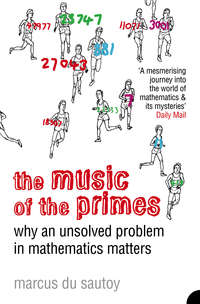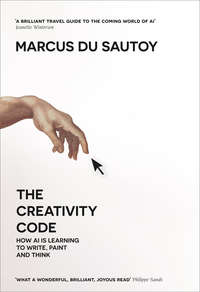
Полная версия
The Number Mysteries: A Mathematical Odyssey through Everyday Life

THE NUMBER
MYSTERIES
A Mathematical Odyssey Through
Every Day Life
MARCUS DU SAUTOY


Copyright
Fourth Estate
An imprint of HarperCollinsPublishers Ltd. 1 London Bridge Street London SE1 9GF
www.harpercollins.co.uk
First published in Great Britain in 2010
Copyright © Marcus du Sautoy
The right of Marcus du Sautoy to be identified as the author of this work has been asserted by him in accordance with the Copyright, Designs and Patents Act 1988
A catalogue record for this book is available from the British Library
All rights reserved under International and Pan-American Copyright Conventions. By payment of the required fees, you have been granted the non-exclusive, non-transferable right to access and read the text of this ebook on-screen. No part of this text may be reproduced, transmitted, down-loaded, decompiled, reverse engineered, or stored in or introduced into any information storage and retrieval system, in any form or by any means, whether electronic or mechanical, now known or hereinafter invented, without the express written permission of HarperCollins ebooks
HarperCollinsPublishers has made every reasonable effort to ensure that any picture content or written content in this ebook has been included or removed in accordance with the contractual or technological constraints in operation at the time of publication
Source ISBN: 9780007278626
Ebook Edition © SEPTEMBER 2010 ISBN: 9780007362561
Version: 2017-08-22
For Shani
CONTENTS
Cover
Title Page
Copyright
Dedication
Introduction
One - The Curious Incident of the Never-ending Primes
Two - The Story of the Elusive Shape
Three - The Secret of the Winning Streak
Four - The Case of the Uncrackable Code
Five - The Quest to Predict the Future
Picture Credits
Keep Reading
A Note on Websites
Index
Acknowledgements
About the Author
Also by Marcus du Sautoy
About the Publisher
INTRODUCTION
Is climate change a reality? Will the solar system suddenly fly apart? Is it safe to send your credit card number over the Internet? How can I beat the casino?
Ever since we’ve been able to communicate, we’ve been asking questions—trying to make predictions about what the future holds, negotiating the environment around us. The most powerful tool that humans have created to navigate the wild and complex world we live in is mathematics.
From predicting the trajectory of a football to charting the population of lemmings, from cracking codes to winning at Monopoly, mathematics has provided the secret language to unlock nature’s mysteries. But mathematicians don’t have all the answers. There are many deep and fundamental questions we are still struggling to crack.
In each chapter of The Number Mysteries I want to take you on a journey through the big themes of mathematics, and at the end of each chapter I will reveal a mathematical mystery that no one has yet been able to solve. These are some of the great unsolved problems of all time.
But solving one of these conundrums won’t just bring you mathematical fame—it will also bring you an astronomical fortune. An America businessman, Landon Clay, has offered a prize of a million dollars for the solution to each of these mathematical mysteries. You might think it strange that a businessman should want to hand out such big prizes for solving mathematical puzzles. But he knows that the whole of science, technology, the economy and even the future of our planet relies on mathematics.
Each of the five chapters of this book introduces you to one of these million-dollar puzzles.
Chapter 1, The Curious Incident of the Never Ending Primes, takes as its theme the most basic object of mathematics: number. I will introduce you to the primes, the most important numbers in mathematics but also the most enigmatic. A mathematical million awaits the person who can unravel their secrets.
In Chapter 2, The Story of the Elusive Shape, we take a journey through nature’s weird and wonderful shapes: from dice to bubbles, from tea bags to snowflakes. Ultimately we tackle the biggest challenge of them all—what shape is our universe?
Chapter 3, The Secret of the Winning Streak, will show you how the mathematics of logic and probability can give you the edge when it comes to playing games. Whether you like playing with Monopoly money or gambling with real cash, mathematics is often the secret to coming out on top. But there are some simple games that still fox even the greatest minds.
Cryptography is the subject of Chapter 4, The Case of the Uncrackable Code. Mathematics has often been the key to unscrambling secret messages. But I will reveal how you can use clever mathematics to create new codes that let you communicate securely across the Internet, send messages through space and even read your friend’s mind.
Chapter 5 is about what we would all love to able to do: The Quest to Predict the Future. I will explain how the equations of mathematics are the best fortune-tellers. They predict eclipses, explain why boomerangs come back and ultimately tell us what the future holds for our planet. But some of these equations we still can’t solve. The chapter ends with the problem of turbulence, which affects everything from David Beckham’s free-kicks to the flight of an aeroplane, yet it is still one of mathematics’ greatest mysteries.
The mathematics I present ranges from the easy to the difficult. The unsolved problems that conclude each chapter are so difficult that no one knows how to solve them. But I am a great believer in exposing people to the big ideas of mathematics. We get excited about literature when we encounter Shakespeare or Steinbeck. Music comes alive the first time we hear Mozart or Miles Davis. Playing Mozart yourself is tough; Shakespeare can often be challenging, even for the experienced reader. But that doesn’t mean that we should reserve the work of these great thinkers for the cognoscenti. Mathematics is just the same. So if some of the mathematics feels tough, enjoy what you can and remember the feeling of reading Shakespeare for the first time.
At school we are taught that mathematics is fundamental to everything we do. In these five chapters I want to bring mathematics to life, to show you some of the great mathematics we have discovered to date. But I also want to give you the chance to test yourself against the biggest brains in history, as we look at some of the problems that remain unsolved. By the end, I hope you will understand that mathematics really is at the heart of all that we see and everything we do.
ONE
The Curious Incident of the Never-ending Primes
1, 2, 3, 4, 5, … it seems so simple: add 1, and you get the next number. Yet without numbers we’d be lost. Arsenal v Man United—who won? We don’t know. Each team got lots. Want to look something up in the index of this book? Well, the bit about winning the National Lottery is somewhere in the middle of the book. And the Lottery itself? Hopeless without numbers. It’s quite extraordinary how fundamental the language of numbers is to negotiating the world.
Even in the animal kingdom, numbers are fundamental. Packs of animals will base their decision to fight or flee on whether their group is outnumbered by a rival pack. Their survival instinct depends in part on a mathematical ability, yet behind the apparent simplicity of the list of numbers lies one of the biggest mysteries of mathematics.
2, 3, 5, 7, 11, 13, … These are the primes, the indivisible numbers that are the building blocks of all other numbers—the hydrogen and oxygen of the world of mathematics. These protagonists at the heart of the story of numbers are like jewels studded through the infinite expanse of numbers.
Yet despite their importance, prime numbers represent one of the most tantalising puzzles we have come across in our pursuit of knowledge. Knowing how to find the primes is a total mystery because there seems to be no magic formula that gets you from one to the next. They are like buried treasure—and no one has the treasure map.
In this chapter we will explore what we do understand about these special numbers. In the course of the journey we will discover how different cultures have tried to record and survey primes and how musicians have exploited their syncopated rhythm. We will find out why the primes have been used to communicate with extraterrestrials and how they have helped to keep things secret on the Internet. At the end of the chapter I shall unveil a mathematical enigma about prime numbers that will earn you a million dollars if you can crack it. But before we tackle one of the biggest conundrums of mathematics, let us begin with one of the great numerical mysteries of our time.
Why did Beckham choose the 23 shirt?
When David Beckham moved to Real Madrid in 2003, there was a lot of speculation about why he’d chosen to play in the number 23 shirt. It was a strange choice, many thought, since he’d being playing in the number 7 shirt for England and Manchester United. The trouble was that at Real Madrid the number 7 shirt was already being worn by Raúl, and the Spaniard wasn’t about to move over for this glamour-boy from England.
Many different theories were put forward to account for Beckham’s choice, and the most popular was the Michael Jordan theory. Real Madrid wanted to break into the American market and sell lots of replica shirts to the huge US population. But football (or ‘soccer’, as they like to call it) is not a popular game in the States. Americans like basketball and baseball, games that end with scores of 100-98 and in which there’s invariably a winner. They can’t see the point of a game that goes on for 90 minutes and can end 0–0 with no side scoring or winning.
According to this theory, Real Madrid had done their research and found that the most popular basketball player in the world was definitely Michael Jordan, the Chicago Bulls’ most prolific scorer. Jordan sported the number 23 shirt for the whole of his career. All Real Madrid had to do was put 23 on the back of a football shirt, cross their fingers and hope that the Jordan connection would work its magic and they would break into the American market.
Others thought this too cynical, but suggested a more sinister theory. Julius Caesar was assassinated by being stabbed 23 times in the back. Was Beckham’s choice for his back a bad omen? Still others thought that maybe the choice was connected with Beckham’s love of Star Wars (Princess Leia was imprisoned in Detention Block AA23 in the first Star Wars movie). Or was Beckham a secret member of the Discordianists, a modern cult that reveres chaos and has a cabalistic obsession with the number 23?
But as soon as I saw Beckham’s number, a more mathematical solution immediately came to mind. 23 is a prime number. A prime number is a number that is divisible only by itself and 1. 17 and 23 are prime because they can’t be written as two smaller numbers multiplied together, whereas 15 isn’t prime because 15=3×5. Prime numbers are the most important numbers in mathematics because all other whole numbers are built by multiplying primes together.
Take 105, for example. This number is clearly divisible by 5. So I can write 105=5×21. 5 is a prime number, an indivisible number, but 21 isn’t: I can write it as 3×7. So 105 can be written as 3 × 5 × 7. But this is as far as I can go. I’ve got down to the primes, the indivisible numbers from which the number 105 is built. I can do this with any number since every number is either prime and indivisible, or else it isn’t prime and can be broken down into smaller indivisible numbers multiplied together.
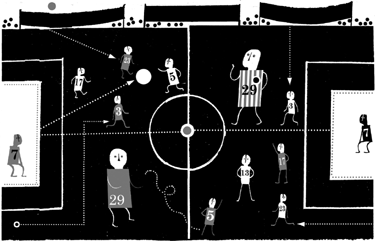
FIGURE 1.01
The primes are the building blocks of all numbers. Just as molecules are built from atoms such as hydrogen and oxygen or sodium and chlorine, numbers are built from primes. In the world of mathematics, the numbers 2, 3 and 5 are like hydrogen, helium and lithium. That’s what makes them the most important numbers in mathematics. But they were clearly important to Real Madrid too.
When I started looking a little closer at Real Madrid’s football team, I began to suspect that perhaps they had a mathematician on the bench. A little analysis revealed that at the time of Beckham’s move, all the Galácticos, the key players for Real Madrid, were playing in prime number shirts: Carlos (the building block of the defence) number 3; Zidane (the heart of the midfield) number 5; Raúl and Ronaldo (the foundations of Real’s strikers) 7 and 11. So perhaps it was inevitable that Beckham got a prime number, a number that he has become very attached to. When he moved to LA Galaxy he insisted on taking his prime number with him in his attempt to woo the American public with the beautiful game.
A prime number fantasy football game
Each player cuts out three Subbuteostyle players and chooses different prime numbers to write on their backs. Use one of the Euclid footballs from Chapter 2 (page 66).
The ball starts with a player from Team 1. The aim is to make it past the three players in the opponent’s team. The opponent chooses the first player to try to tackle Team 1’s player. Roll the dice. The dice has six sides: white 3, white 5 and white 7, and black 3, black 5 and black 7. The dice will tell you to divide your prime and the prime of your opponent’s player by 3, 5 or 7 and then take the remainder. If it is a white 3, 5 or 7, your remainder needs to equal or beat the opposition. If it is black, you need to equal or get less than your opponent.
To score, you must make it past all three players and then go up against a random choice of prime from the opposition. If at any point the opposition beats you, then possession switches to the opposition. The person who has gained possession then uses the player who won to try to make it through the opposition’s three players. If Team 1’s shot at goal is missed then Team 2 takes the ball and gives it to one of their players.
The game can be played either against the clock or first to three goals.
This may sound totally irrational coming from a mathematician, someone who is meant to be a logical analytical thinker. However, I also play in a prime number shirt for my football team, Recreativo Hackney, so I felt some connection with the man in 23. My Sunday League team isn’t quite as big as Real Madrid and we didn’t have a 23 shirt, so I chose 17, a rather nice prime—as we’ll see later. But in our first season together our team didn’t do particularly well. We play in the London Super Sunday League Division 2, and that season we finished rock bottom. Fortunately this is the lowest division in London, so the only way was up.
But how were we to improve our league standing? Maybe Real Madrid were on to something—was there was some psychological advantage to be had from playing in a prime number shirt? Perhaps too many of us were in non-primes, like 8, 10 or 15. The next season I persuaded the team to change our kit, and we all played in prime numbers: 2, 3, 5, 7, … all the way up to 43. It transformed us. We got promoted to Division 1, where we quickly learnt that primes last only for one season. We were relegated back down to Division 2, and are now on the look-out for a new mathematical theory to boost our chances.
Should Real Madrid’s keeper wear the number 1 shirt?
If the key players for Real Madrid wear primes, then what shirt should the keeper wear? Or, put mathematically, is 1 a prime? Well, yes and no. (This is just the sort of maths question everyone loves—both answers are right.) Two hundred years ago, tables of prime numbers included 1 as the first prime. After all, it isn’t divisible, since the only whole number that divides it is itself. But today we say that 1 is not a prime because the most important thing about primes is that they are the building blocks of numbers. If I multiply a number by a prime, I get a new number. Although 1 is not divisible, if I multiply a number by 1 I get the number I started with, and on that basis we exclude 1 from the list of primes, and start at 2.
Clearly Real Madrid weren’t the first to discover the potency of the primes. But which culture got there first—the Ancient Greeks? The Chinese? The Egyptians? It turned out that mathematicians were beaten to the discovery of the primes by a strange little insect.
Why does an American species of cicada like the prime 17?
In the forests of North America there is a species of cicada with a very strange life cycle. For 17 years these cicadas hide underground doing very little except sucking on the roots of the trees. Then in May of the 17th year they emerge at the surface en masse to invade the forest: up to a million of them appearing for each acre.
The cicadas sing away to one another, trying to attract mates. Together they make so much noise that local residents often move out for the duration of this 17-yearly invasion. Bob Dylan was inspired to write his song ‘Day of the Locusts’ when he heard the cacophony of cicadas that emerged in the forests round Princeton when he was collecting an honorary degree from the university in 1970.
After they’ve attracted a mate and become fertilized, the females each lay about 600 eggs above ground. Then, after six weeks of partying, the cicadas all die and the forest goes quiet again for another 17 years. The next generation of eggs hatch in midsummer, and nymphs drop to the forest floor before burrowing through the soil until they find a root to feed from, while they wait another 17 years for the next great cicada party.
It’s an absolutely extraordinary feat of biological engineering that these cicadas can count the passage of 17 years. It’s very rare for any cicada to emerge a year early or a year too late. The annual cycle that most animals and plants work to is controlled by changing temperatures and the seasons. There is nothing that is obviously keeping track of the fact that the Earth has gone round the Sun 17 times and can then trigger the emergence of these cicadas.
For a mathematician, the most curious feature is the choice of number: 17, a prime number. Is it just a coincidence that these cicadas have chosen to spend a prime number of years hiding underground? It seems not. There are other species of cicada that stay underground for 13 years, and a few that prefer to stay there for 7 years. All prime numbers. Rather amazingly, if a 17-year cicada does appear too early, then it isn’t out by 1 year, but generally 4 years, apparently shifting to a 13-year cycle. There really does seem to be something about prime numbers that is helping these various species of cicada. But what is it?
While scientists aren’t too sure, there is a mathematical theory that has emerged to explain the cicadas’ addiction to primes. First, a few facts. A forest has at most one brood of cicada, so the explanation isn’t about sharing resources between different broods. In most years there is somewhere in the United States where a brood of prime number cicadas is emerging. 2009 and 2010 are cicadafree. In contrast, 2011 sees a massive brood of 13-year cicadas appearing in the south-eastern USA. (Incidentally, 2011 is a prime, but I don’t think the cicadas are that clever.)
The best theory to date for the cicadas’ prime number life cycle is the possible existence of a predator that also used to appear periodically in the forest, timing its arrival to coincide with the cicadas’ and then feasting on the newly emerged insects. This is where natural selection kicks in, because cicadas that regulate their lives on a prime number cycle are going to meet predators far less often than non-prime number cicadas will.
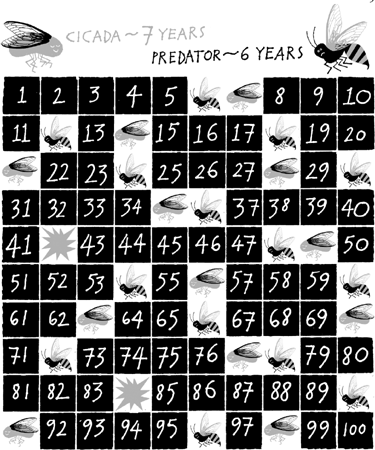
FIGURE 1.02 The interaction over 100 years between populations of cicadas with a 7-year life cycle and predators with a 6-year life cycle.
For example, suppose that the predators appear every 6 years. Cicadas that appear every 7 years will coincide with the predators only every 42 years. In contrast, cicadas that appear every 8 years will coincide with the predators every 24 years; cicadas appearing every 9 years will coincide even more frequently: every 18 years.
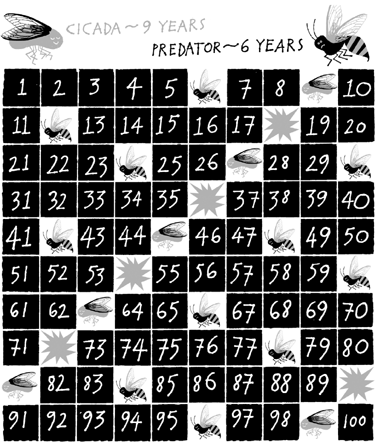
FIGURE 1.03 The interaction over 100 years between populations of cicadas with a 9-year life cycle and predators with a 6-year life cycle.
Across the forests of North America there seems to have been real competition to find the biggest prime. The cicadas have been so successful that the predators have either starved or moved out, leaving the cicadas with their strange prime number life cycle. But as we shall see, cicadas are not the only ones to have exploited the syncopated rhythm of the primes.
Cicadas v predators

Cut out the predators and the two cicada families. Place predators on the numbers in the six times table. Each player takes a family of cicadas. Take three standard six-sided dice. The roll of the dice will determine how often your family of cicadas appears. For example, if you roll an 8, then place cicadas on each number in the 8 times table. But if there is a predator already on a number, you can’t place a cicada—for example, you can’t place a cicada on 24 because it’s already occupied by a predator. The winner is the person with the most cicadas on the board. You can vary the game by changing the period of the predator, from 6 to some other number.

How are the primes 17 and 29 the key to the end of time?
During the Second World War, the French composer Olivier Messiaen was incarcerated as a prisoner of war in Stalag VIII-A, where he discovered a clarinettist, a cellist and a violinist among his fellow inmates. He decided to compose a quartet for these three musicians and himself on piano. The result was one of the great works of twentieth-century music: Quatuor pour la fin du temps—‘The Quartet for the End of Time’. It was first performed to inmates and prison officers inside Stalag VIII-A, with Messiaen playing a rickety upright piano they found in the camp.


